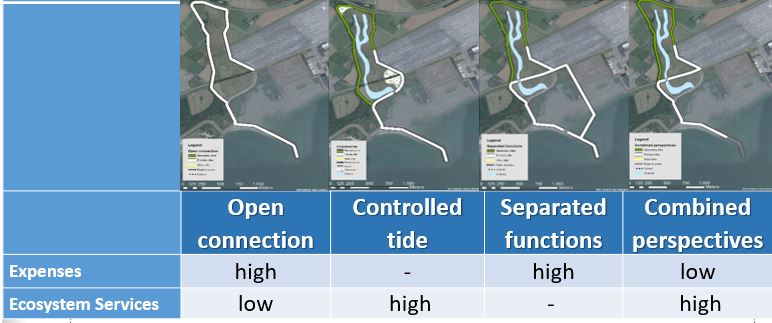Orientation phase Schorerpolder
|
(Label: visualeditor)
|
(Label: visualeditor)
|
||
| Regel 13: | Regel 13: | ||
==== Limits and opportunities ==== |
==== Limits and opportunities ==== |
||
The possibilities for Schorerpolder are limited because of its location, what is to be found below and above the surface and where it is currently used for. The layer approach was used to define the spatial impact of the area. The most important outcome of the research was the amount of cables and tubes that where present in the area, all of importance to the harbor (Lambregts, 2018). |
The possibilities for Schorerpolder are limited because of its location, what is to be found below and above the surface and where it is currently used for. The layer approach was used to define the spatial impact of the area. The most important outcome of the research was the amount of cables and tubes that where present in the area, all of importance to the harbor (Lambregts, 2018). |
||
| − | [[Bestand:4 alternative designs.jpg|miniatuur|Four alternative designs for Schorerpolder.]] |
+ | [[Bestand:4 alternative designs.jpg|miniatuur|Figure 1: Four alternative designs for Schorerpolder.|772x772px]] |
==== Designs ==== |
==== Designs ==== |
||
The four different designs of Schorerpolder, were assessed based on the ecosystem services and expenses on creation and maintenance. |
The four different designs of Schorerpolder, were assessed based on the ecosystem services and expenses on creation and maintenance. |
||
Versie van 20 aug 2018 om 15:37
Inhoud
Start project
On the first of February 2018, the project started to map different alternative designs based on previous studies and outcomes of new studies. Two researchers of the Building with Nature group of HZ coordinated this research and guided the involved students. The expertise of researchers of water safety and spatial planning, civil engineering and vitality and tourism was added. A stakeholder meeting was organised the 14th of June to share the outcomes of the first six months and to organize discussion about the different alternative designs.
Ecosystem services
Groups of students compared the alternative designs for ecosystem services:
- Sustainable use of abiotic resources (Sinke et al. 2018)
- Use as a nursery for fish (Lee et al. 2018)
- Provision of habitat and foraging area for birds (Burger et al. 2018)
- Enhance the biodiversity of hard structures in the intertidal zone of the area (Metekohij et al. 2018)
- Quantification of primary production and carbon dioxide sequestration (Mol et al. 2018)
- Quantification of the water purification capacity of salt marshes (Correa et al. 2018)
- Possibilities for aquaculture (Abbenis, 2018)
- Opportunities for experiencing nature and tourism (Kruizinga 2018)
Limits and opportunities
The possibilities for Schorerpolder are limited because of its location, what is to be found below and above the surface and where it is currently used for. The layer approach was used to define the spatial impact of the area. The most important outcome of the research was the amount of cables and tubes that where present in the area, all of importance to the harbor (Lambregts, 2018).
Designs
The four different designs of Schorerpolder, were assessed based on the ecosystem services and expenses on creation and maintenance.
- Open connection: Opening up the polder completely would allow for natural processes that make intertidal areas so unique to shape and form the area. By letting these tides flow through the area unhindered the potential intertidal area is maximized which is beneficial for wading birds but downside is that all dikes would have to be overhauled.
- Controlled tide: This design needs less changes in the primary dike than the previous one and is beneficial as fish nursery (e.g. eel) because of the presence of a gully and denitrification can occur in anaerobic environments. In addition salt marshes can develop more easily and can store CO2.
- Separated functions: This design is expensive as a new dam will be build to separate the harbor from the new intertidal area. Still this leads to opportunities for biodiversity on dams and dikes. The high sedimentation rate will lead to phosphorus burial and options to use the sediment as abiotic resource.
- Combined perspectives: By combining low costs and maximizing ecosystem services, the fourth design was born. In addition this design makes aquaculture possible.
Conclusion
The interactive meeting showed that the majority of the stakeholders were in favor of designs controlled tide and combined perspectives. Further research needs to be done on CO2 reduction capacity of salt marshes.
References
- Bird foraging habitat, Burger, Jan, Hassan Al-bahri, Lorenzo Franzoni, David Gooren, Jort Rootlieb, HZ, 14 juni 2018.
- Water purification capacity Schorerpolder, Correa, Ximena, Pamela Morales , Lorenzo Somai, Melle den Toonder, Leonardo Gemelli, HZ, 14 juni 2018.
- Wellbeing in delta's, Kruizinga, Peter, 14 juni 2018.
- Nursery for Fish Eel, Lee, June and Lies Hamelink, HZ, 14 juni 2018.
- Infographic, Martens, M., 29 augustus 2018.
- Biodiversity on hard substrate, Metekohij, Tamarindo, Elleke de Koeijer, Han Cao, Jochem Rozinga, HZ, 14 juni 2018.
- Poster CO2 emissie studenten 2018, Mol, Yoni, Pjotr Carelse and Tigli Maddalena, HZ, 14 juni 2018.
- Abiotic resource_sediment, Sinke, Melanie, Alexander Noordegraaf, Htun Thiri Naing, Yifei Song, HZ, 14 juni 2018.
